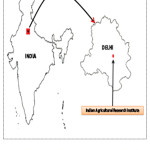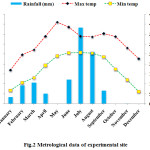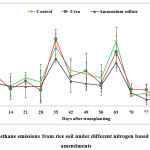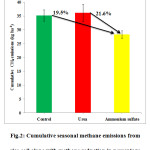Impact of Nitrogen Fertilizers on Methane Emissions from Flooded Rice
Sandeep K. Malyan1 * , Arti Bhatia1 , Om Kumar1 and Ritu Tomer1
1
Center for Environment Science and Climate Resilient Agriculture,
Indian Agricultural Research Institute,
New Delhi,
110012
India
Corresponding author Email: sandeepkmalyan@gmail.com
DOI: http://dx.doi.org/10.12944/CWE.11.3.20
Methane is second most potent greenhouse gas emitted under anaerobic condition in rice soils. Effects of different nitrogen fertilizer application on methane emissions in flooded paddy field were studied. The experiment was laid out in a randomized complete block design with three treatments and three replications. The treatments were control (0 kg N ha-1), urea (120 kg N ha-1) and ammonium sulfate (120 kg N ha-1). In all treatments P (60 kg P2O5 ha-1) along with K (40 kg K2O ha-1) were also applied as basal dose. The cumulative seasonal methane flux was highest in urea 36.3 (kg ha-1) followed by control 35.2 (kg ha-1) and ammonium sulfate 28.5 (kg ha-1). Ammonium sulfate application reduced total seasonal emission by 19.5% as compared to control while it reduced CH4 emissions by 21.6% as compared to urea application. On the basis of this study we can conclude that application of ammonium sulfate is an effective tool for mitigating methane emissions from rice soils.
Copy the following to cite this article:
Malyan S. K, Bhatia A, Kumar O, Tomer R. Impact of Nitrogen Fertilizers on Methane Emissions from Flooded Rice. Curr World Environ 2016;11(3). DOI:http://dx.doi.org/10.12944/CWE.11.3.20
Copy the following to cite this URL:
Malyan S. K, Bhatia A, Kumar O, Tomer R. Impact of Nitrogen Fertilizers on Methane Emissions from Flooded Rice. Curr World Environ 2016;11(3). Available from: http://www.cwejournal.org/?p=16574
Download article (pdf)
Citation Manager
Publish History
Select type of program for download
| Endnote EndNote format (Mac & Win) | |
| Reference Manager Ris format (Win only) | |
| Procite Ris format (Win only) | |
| Medlars Format | |
| RefWorks Format RefWorks format (Mac & Win) | |
| BibTex Format BibTex format (Mac & Win) |
Article Publishing History
| Received: | 2016-11-04 |
|---|---|
| Accepted: | 2016-12-11 |
Introduction
Methane (CH4) atmospheric concentration has significantly rises due anthropogenic activity. Graedel and McRae1 presented first evidence that atmospheric concentration of CH4 is increasing. In agriculture submerged rice (Oryza sativa L.) soils are the major source of CH4 emission to atmosphere. Rice is second most consumed cereal in world after corn and out of total rice 90% is cultivated in Asia under irrigated conditions. Under continues standing water soil redox potential (Eh) drops sharply within few days and leads to process methanogenesis in soil.2 In methanogensis, soil archaea methanogens degraded organic matter and produce CH4.3 CH4 emission from rice soil is a net balance of production by methanogens in reducing environment after oxidation by methanotrophs in oxidizing environment and it is influenced by several factors such as water conditions, Eh, soil temperature, pH, fertilizer managements, and organic matter.4-5 Water management’s practices such as alternate drying and wetting, mid-season drainage, system of rice intensification etc were effective tool to reduce CH4 emission from rice cultivation. Water managements practices have limitation in lowland area were water management is difficult task so there is need for other effective interventions for CH4 reduction from lowland or continues flooded rice soils. CH4 is second most potent greenhouse gas after carbon dioxide and it is 25 times greenhouses gas as compared to carbon dioxide.6-7 According to IPCC8 CH4 contributes 16% of total emissions at global level and out of total rice field alone contribute 10% of total CH4 emission at global level.9 Kumar et al.,10 reported that by the end of twenty first century global mean temperature may rise up to 1.5ËšC due to raise in global greenhouses gases atmospheric concentrations. Global warming is major concerned of 21st century for scientific and policy maker. As the world population was increasing so under such scenario CH4 mitigation from rice field needed without having any negative impact on rice production. Rice production depends on type and amount of nitrogen (N) based fertilizer applied for cultivation. N based fertilizer amendments may be used for CH4 emissions mitigation from the rice soil. Impact of different N based fertilizer on CH4 emission is less elevated so it is needed. The objective of this field experiment is to evaluate the impact of nitrogen fertilizer on CH4 emissions from rice soil under continuous flooded condition.
Material and Methods
Site Descriptions
Field experiment was carried out at the research farm of Indian Agricultural Research Institute, New Delhi, India, during kharif cropping season of year 2015 (Fig. 1).The climatic condition of the region was sub-tropical, semi arid that was characterized by dry winter and maximum rainfall occurs during from June to September of year (Fig. 2).The soil in study site was sandy loam in texture and pri-transplanting physicochemical of experimental site soil are mentioned in Table (1).
 |
|
 |
|
Table 1: Pri-transplanting physicochemical properties of the experimental site
|
Soil parameter Value |
|
|
Sand (%) |
46 |
|
Slit (%) |
32 |
|
Clay (%) |
22 |
|
pH (1:2.5 :: soil: water) |
8.4 |
|
Organic C (%) |
0.58 |
|
CEC* (c mol kg-1) |
7.3 |
|
Hydraulic conductivity (cm d-1) |
4.7 |
|
Olsen P (kg ha-1) |
31.9 |
|
KMnO4 extractable N (kg ha-1) |
250 |
|
NH4+-N (kg ha-1) |
24.8 |
|
NO3--N (kg ha-1) |
34.1 |
|
Moisture content at field capacity (%) |
21.2 |
Experimental design and treatments details
The experiments consist of three treatments with three replicate each which are arranged in RBD. Composition and dose of various treatments were mentioned in Table (2). Pusa Basmtai 1509 variety of rice (Oryza sativa L.) was adopted for conducting the experiment. Two to three rice seedlings (23 days age) were transplanted at 15 x 20 cm spacing. Continuous flooding condition at 8 ± 4 cm water level was maintained by groundwater irrigation for entire cropping period. The field was naturally allowed to dry three weeks before harvesting of crop. No chemical interventions (pesticide and herbicide) were applied to avoid their additional effects. Weeding in done manual when were required.
Table 2: Different treatments used during rice cultivation
|
Treatment |
Dose |
Method of application |
|
Control |
N (0 kg N ha-1 ), P (0 kg P2O5 ha-1), K (0 kg K2O ha-1) |
Not applicable |
|
Urea |
N (120 kg N ha-1 ), P (60 kg P2O5 ha-1), K (40 kg K2O ha-1) |
P and K were applied basally, while N (Urea) applied in three splits in 50% (basal) and, 25% (tillering) and 25% (panicle initiation) of total dose. |
|
Ammonium sulfate (AS) |
AS (120 kg N ha-1), P (60 kg P2O5 ha-1), K (40 kg K2O ha-1), |
P and K were applied basally, while N (Ammonium sulfate) applied in three splits in 50% (basal) and, 25% (tillering) and 25% (panicle initiation) of total dose. |
Methane sampling collection and analysis
Gas samples were collected at 7 days regular interval throughout the rice cultivation by manual closed chamber technique.11 Gas samples were collected between 9 am to 11 am and samples were withdrawn from top of the chamber using 20 ml air-tight syringes at 0, 1/2 and 1 hrs. Concentration of CH4 gas in the collected gas samples were measured by using gas chromatography equipped with column and a flame ionization detector.
Result and Discussion
Methane emission among all treatments was low during first three weeks and significantly increased with plant growth and lower soil Eh. The highest flux peak was observed at 35 days after transplanting (DAT) and second peak occur at 63 DAT (Fig 1).
 |
|
Two higher CH4 peaks may be due to degradation of soil organic matter by methanogens bacteria under anaerobic conditions and similar flux were also reported by12 in rice soil. The cumulative seasonal CH4 flux was 35.2 kg ha-1 under the control treatment The highest cumulative CH4 flux was recorded in urea (36.3 kg ha-1) treatment followed by control (35.2kg ha-1) and ammonium sulfate (28.3 kg ha-1). As compare to control, urea fertilizer application enhances CH4 emissions by 2.72% and ammonium sulfate amendments reduce CH4 emissions by 19.5% as compared to control (Fig. 2). Ammonium sulfate application mitigates total seasonal CH4 emissions by 21.6% over to urea (Fig. 2).
The higher CH4 emission under nitrogen applied plots over no nitrogen amendments has been reported.13 Urea application enhances the ammonium ions concentration in soil and due to structural symmetry between CH4 and ammonium ion3 methanotrophs bind with ammonium ions instead of CH4 therefore results in less CH4 oxidation by methanotrophs in soil which final result in higher CH4 emission from soil.14
Minami15 observed about more than 15% reduction in average CH4 flux from rice soil by soil incorporated with ammonium sulfate at 200 kg N ha-1 rate as compared to 200 kg N ha-1 urea incorporation. Similar finding were also observed by Ali et al.,16 and they reported 16% and 21% reduction in total seasonal CH4 flux by ammonium sulfate over urea in upland and lowland rice soil in Bangladesh respectively. On ammonium sulfate ions soil concentration of active sulfate ions increases16 which result in higher population of sulfate reducing bacteria in soil. Sulfate reducing bacteria compete with methanogens bacteria for organic matter as they both feed on similar substrate5 therefore on application of ammonium sulfate suppressed methanogens activity in soil which result in CH4 flux reduction form rice soil.
 |
|
Conclusions
In is field study we evaluate the impact different nitrogen based fertilizer impact on methane emission from paddy soil. A total cumulative methane emission was highest in urea applied plots and lowest in ammonium sulfate plots. Ammonium sulfate application reduces 19.5% and 21.6% as compare to urea and control respectively. Therefore, based on this field study data it could be suggested that application of ammonium sulfate significantly reduce methane from rice soils.
Acknowledgements
We thank the Director, Dean and PG School of Indian Agricultural Research Institute (IARI), New Delhi for providing all facilities required in this study. Financial support to Mr. Sandeep K. Malyan during Ph.D as UGC-JRF/SRF provided by University Grant Commission (UGC), New Delhi Government of India is gratefully acknowledged.
References
- Graedel, T.E., McRae, J.E., 1980. On the possible increase of the atmospheric methane and carbon monoxide concentrations during the last decade. Geophys. Res. Lett. 7, 977-979.
CrossRef - Kumar, S.S., Malyan, S.K., 2016. Nitrification Inhibitors: A Perspective tool to Mitigate Greenhouse Gas Emission from Rice Soils. Curr. World Environ. 11(2), 423–428.
CrossRef - Malyan, S.K., Bhatia, A., Kumar, A., Gupta, D.K., Singh, R., Kumar, S.S., Tomer, R., Kumar, O., Jain, N., 2016. Methane production, oxidation and mitigation: A mechanistic understanding and comprehensive evaluation of influencing factors. Sci. Total Environ. 1,874-896.
CrossRef - Gupta, D.K., Bhatia, A., Kumar, A., Das, T.K., Jain, N., Tomer, R., Malyan, S.K., Fagodiya, R.K., Dubey, R., Pathak, H., 2016. Mitigation of greenhouse gas emission from rice–wheat system of the Indo-Gangetic plains: Through tillage, irrigation and fertilizer management. Agric. Ecosyst. Environ. 230, 1–9.
CrossRef - Hussain, S., Peng, S., Fahad, S., Khaliq, A., Huang, J., Cui, K., Nie, L., 2015. Rice management interventions to mitigate greenhouse gas emissions: a review. Environ. Sci. Pollut. Res. 22, 3342–3360.
CrossRef - Pramanik, P., Kim, P.J., 2016. Contrasting effects EDTA applications on the fluxes of methane and nitrous oxide emissions from straw-treated rice paddy soils. J. Sci. Food Agric. n/a-n/a. doi:10.1002/jsfa.7727.
CrossRef - Bhatia, , Ghosh, A., Kumar, V., Tomer, R., Singh, S.D., Pathak, H., 2011. Effect of elevated tropospheric ozone on methane and nitrous oxide emission from rice soil in north India. Agric. Ecosyst. Environ. 144, 21–28.
CrossRef - International Panel on Climate Change, Climate Change (2014) Mitigation of Climate Change. Contribution of Working Group III to the Fifth Assessment Report of the Intergovernmental Panel on Climate Change [Edenhofer, O., R. Pichs-Madruga, Y. Sokona, E. Farahani, S. Kadner, K.Seyboth, A. Adler, I. Baum, S. Brunner, P. Eickemeier, B. Kriemann, J. Savolainen, S. Schlömer, C. von Stechow, T. Zwickel and J.C. Minx (eds.)]. Cambridge University Press, Cambridge, United Kingdom and New York, NY, USA.
- Global Methane Initiative. 2011. Global methane emissions and mitigation opportunities. GMI, [Online] Available: globalmethane. org (August 17, 2011).
- Kumar, R., Mina, U., Gogoi, R., Bhatia, A., Harit, R.C., 2016. Effect of elevated temperature and carbon dioxide levels on maydis leaf blight disease tolerance attributes in maize . Ecosyst. Environ. 231, 98–104.
CrossRef - Hutchinson, G.L, Mosier, A.R., 1981. Improved Soil Cover Method for Field Measurement of Nitrous Oxide Fluxes. Soil Sci. Soc. Am. J. 45, 311-316.
CrossRef - Suryavanshi, P., Singh, Y. V., Prasanna, R., Bhatia, A., Shivay, Y.S., 2013. Pattern of methane emission and water productivity under different methods of rice crop establishment. Paddy Water Environ. 11, 321–329.
CrossRef - Xia L, Wang S, Yan X (2014) Effects of long-term straw incorporation on the net global warming potential and the net economic benefit in a rice–wheat cropping system in China. Agric. Ecosyst. Environ. 197:118-127.
CrossRef - Schimel, J., 2000. Rice, microbes and methane. Nature 403, 375, 377.
- Minami, K., 1995. The effect of nitrogen fertilizer use and other practices on methane emission from flooded rice. Fertil. Res. 40, 71–84.
CrossRef - Ali, M.A., Farouque, M.G., Haque, M., Kabir, A.U., 2012. Influence of soil amendments on mitigating methane emissions and sustaining rice productivity in paddy soil ecosystems of Bangladesh. J. Environ. Sci. Nat. Resour. 5, 179–185.
CrossRef






